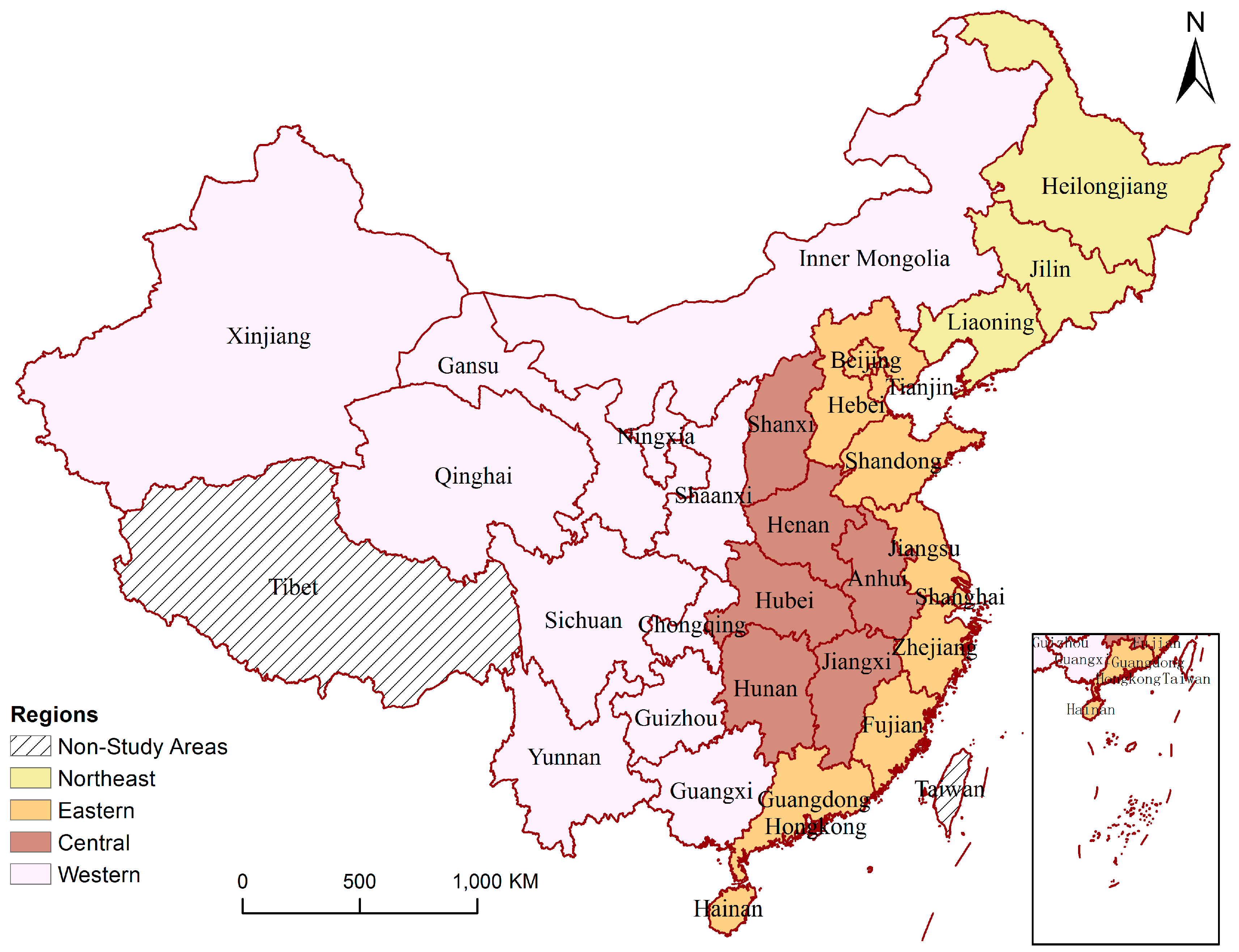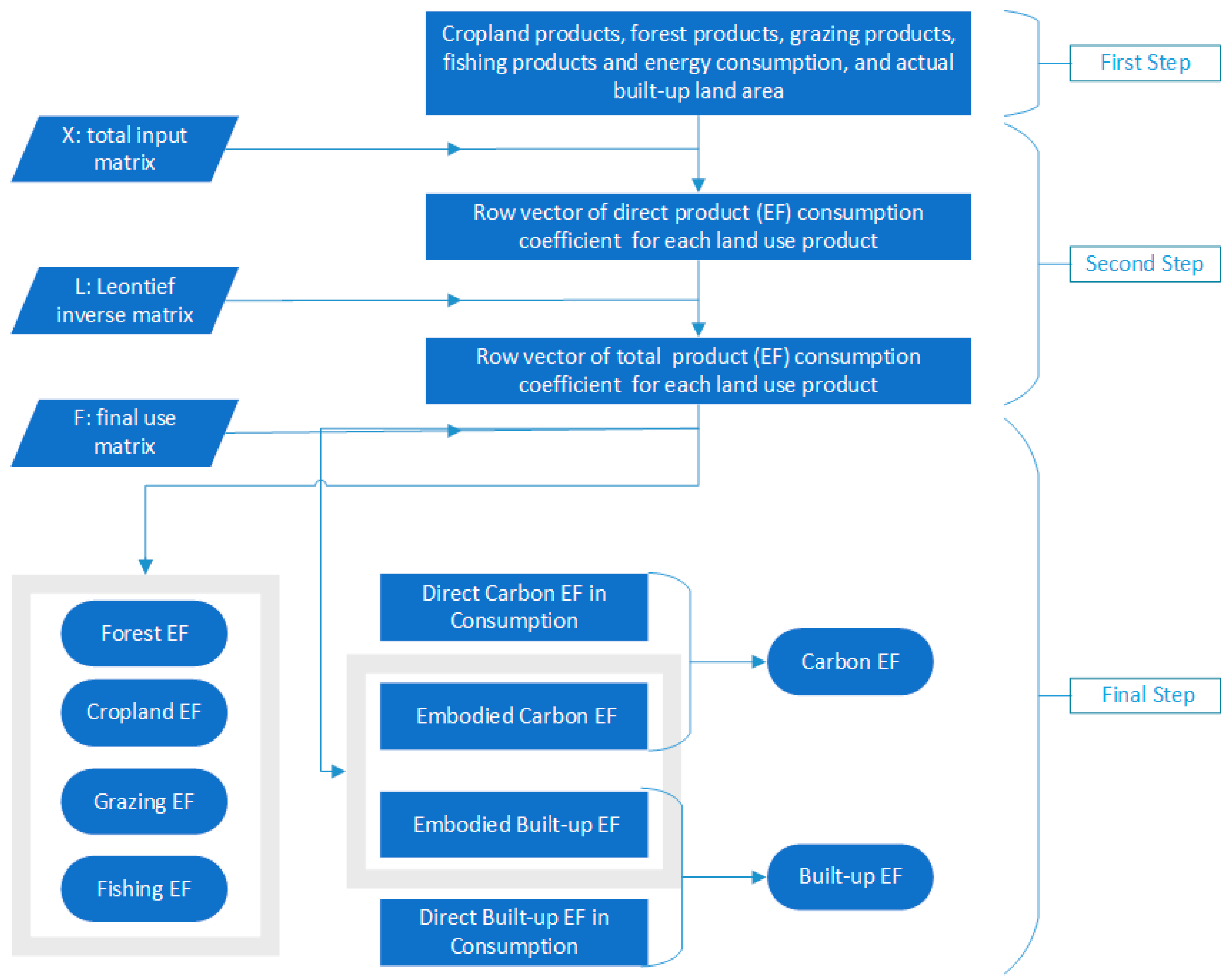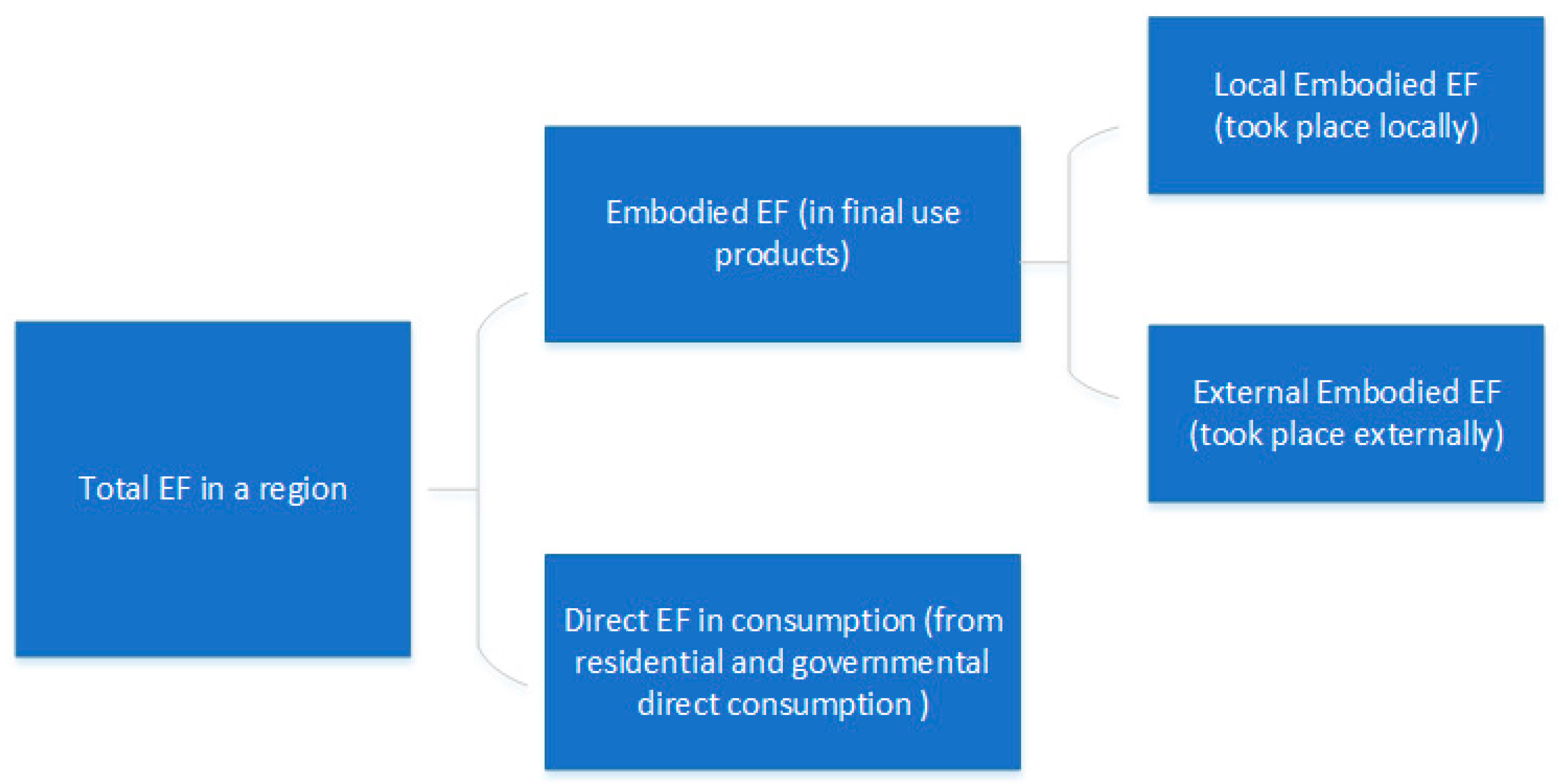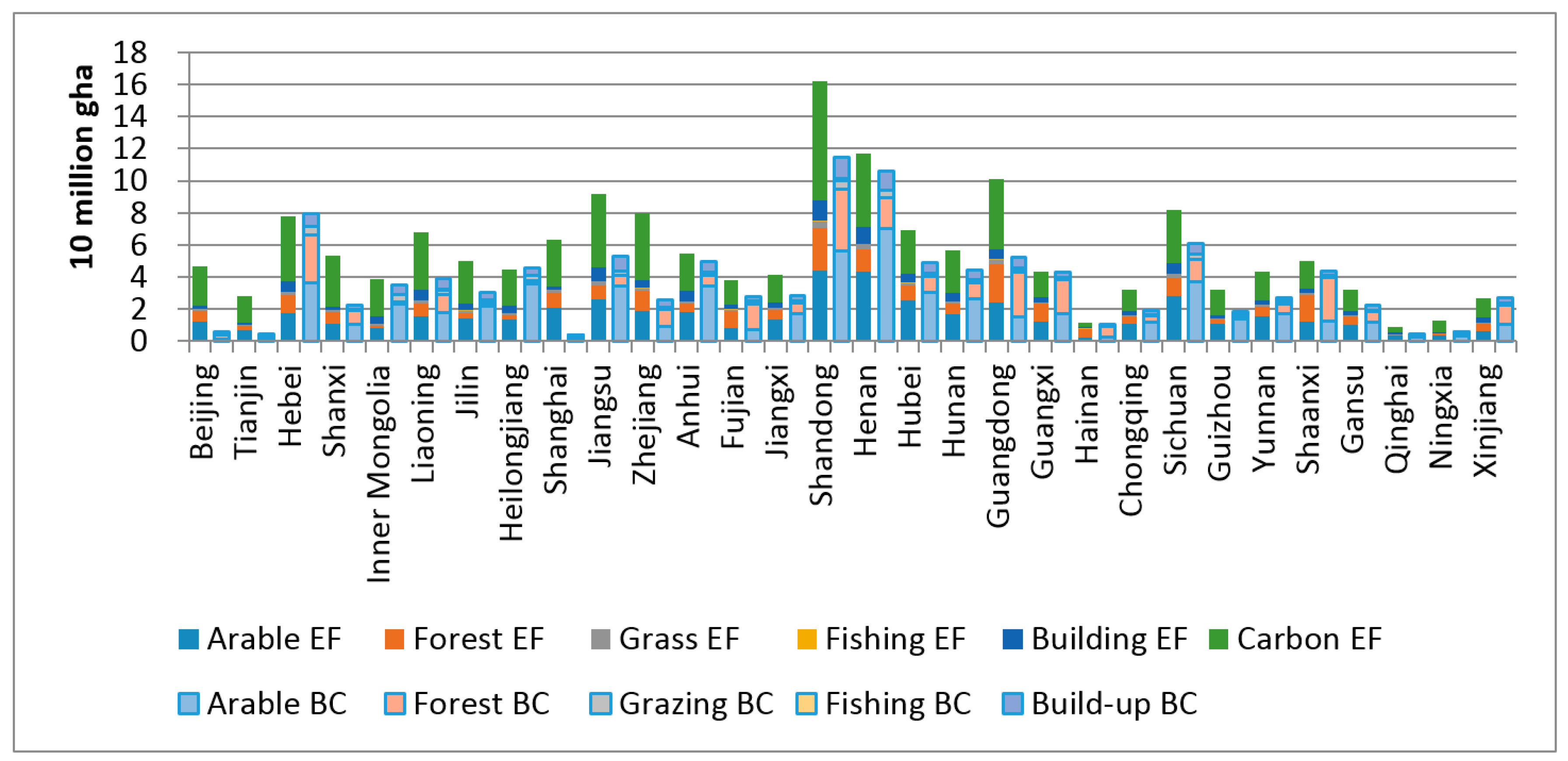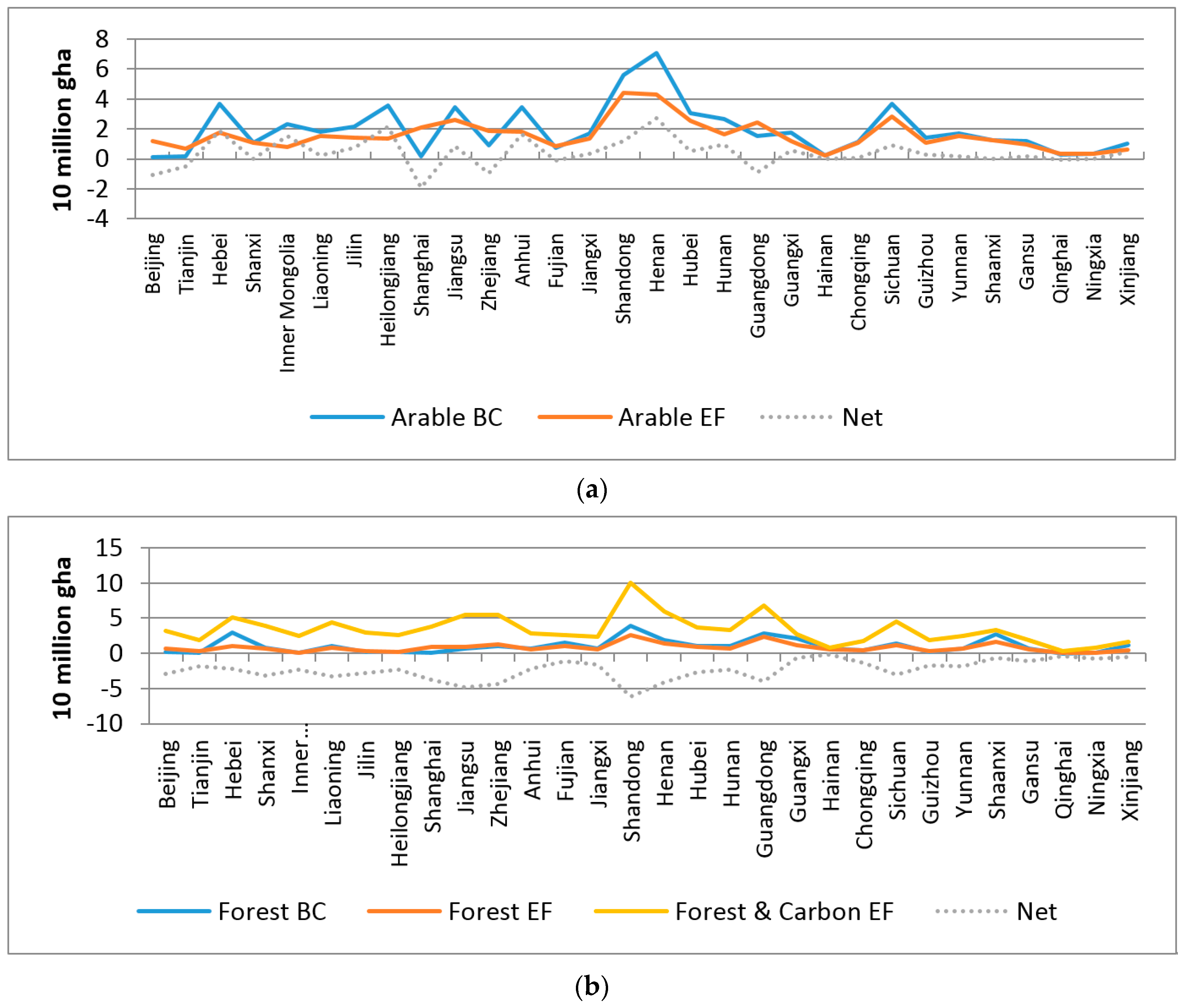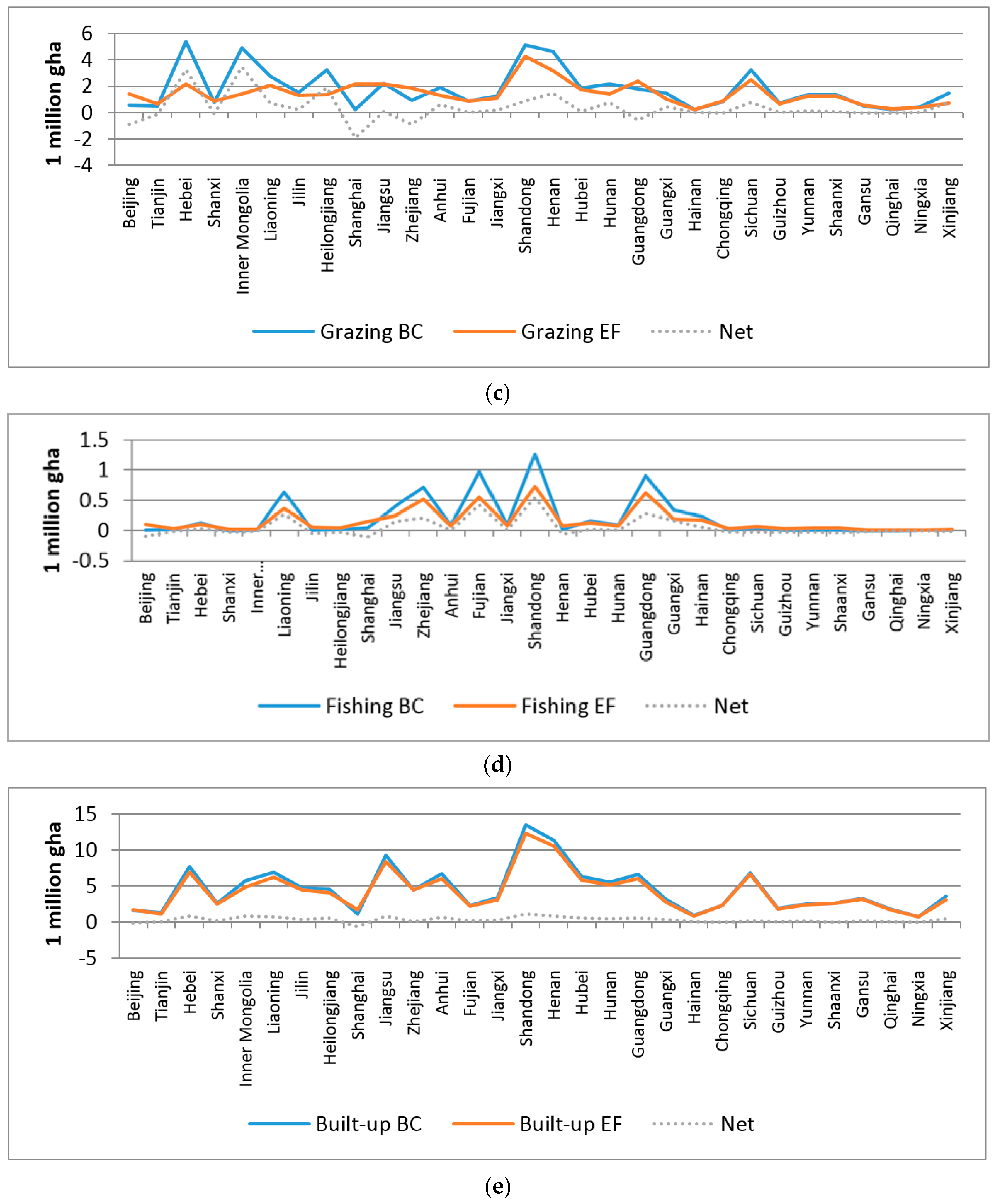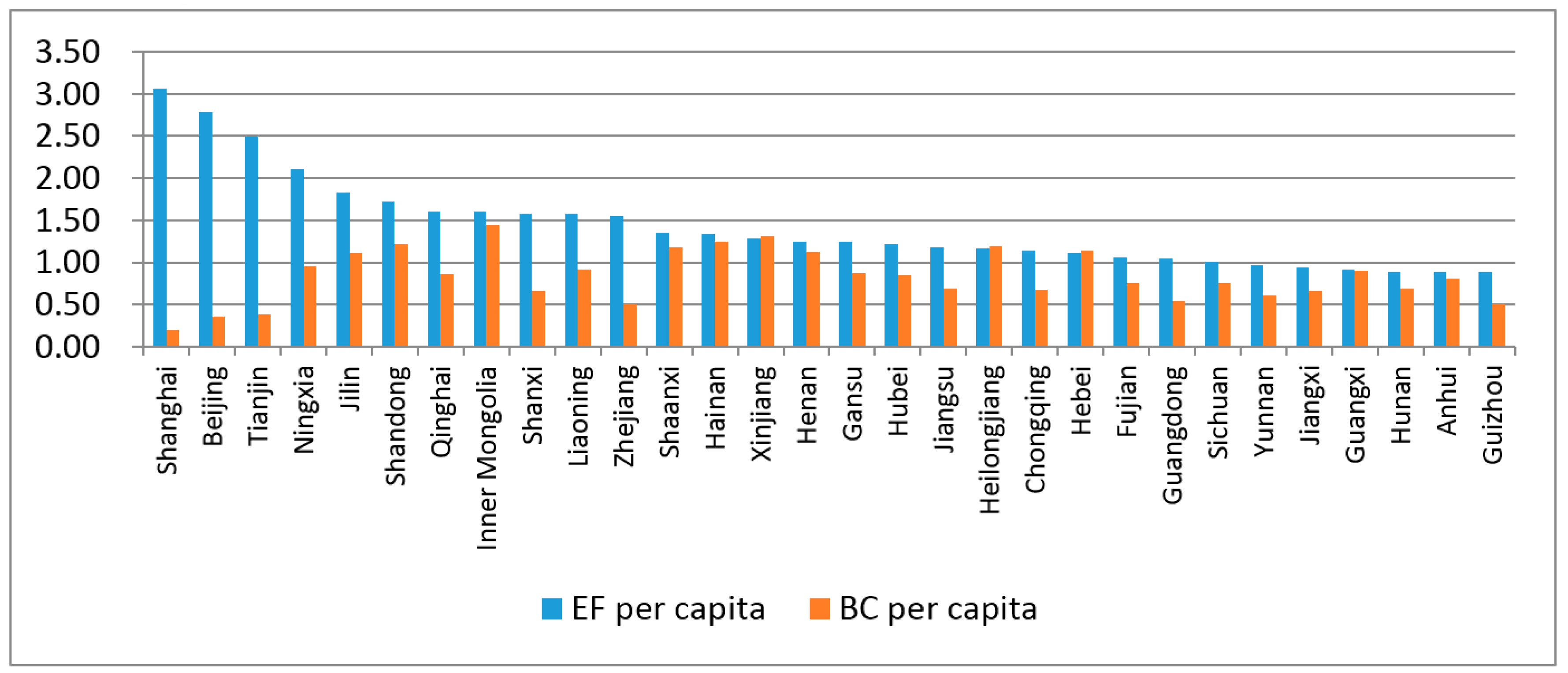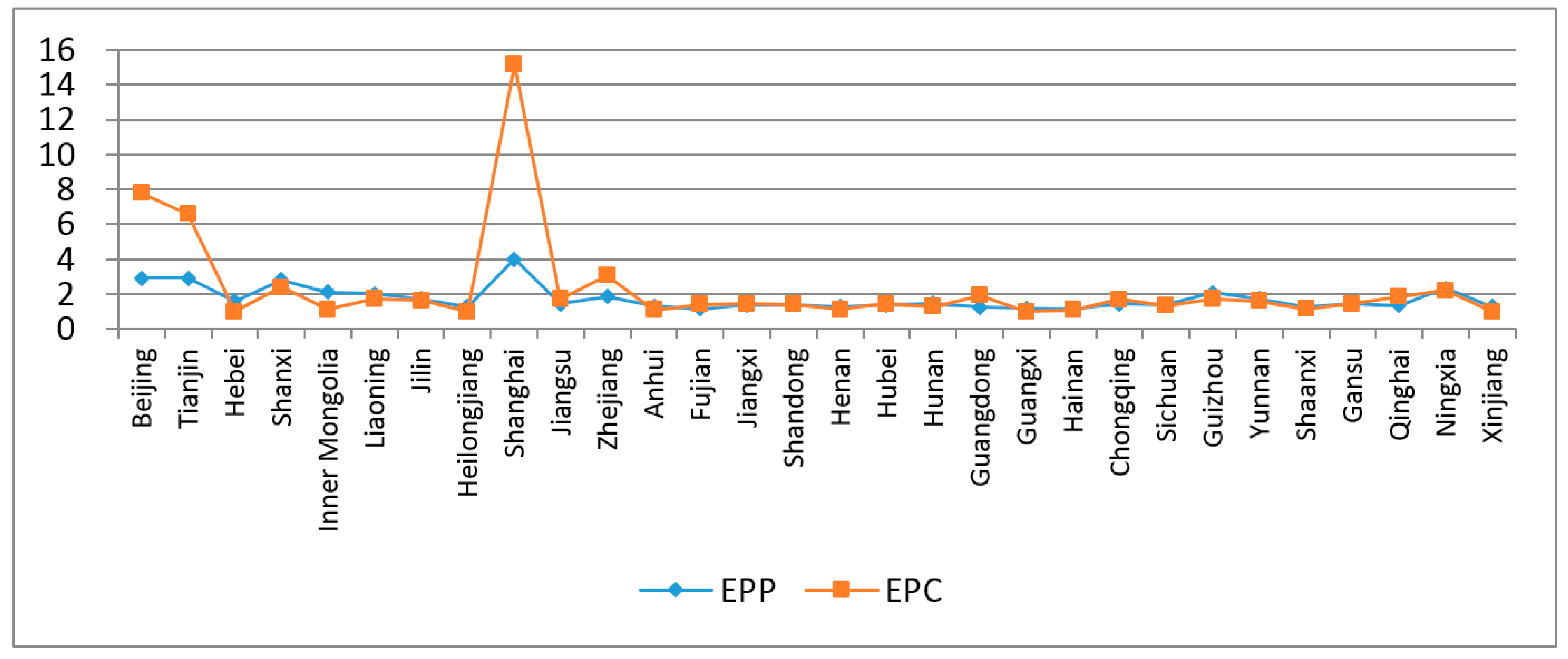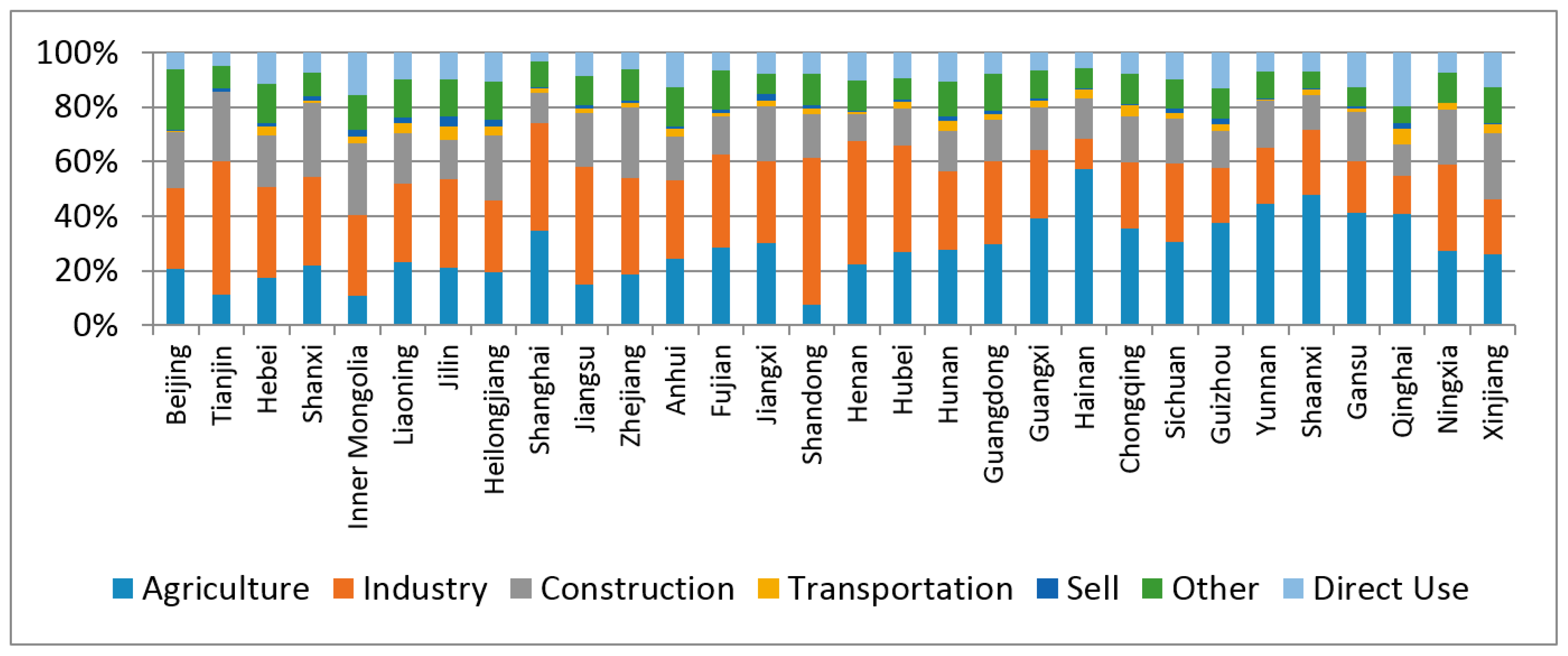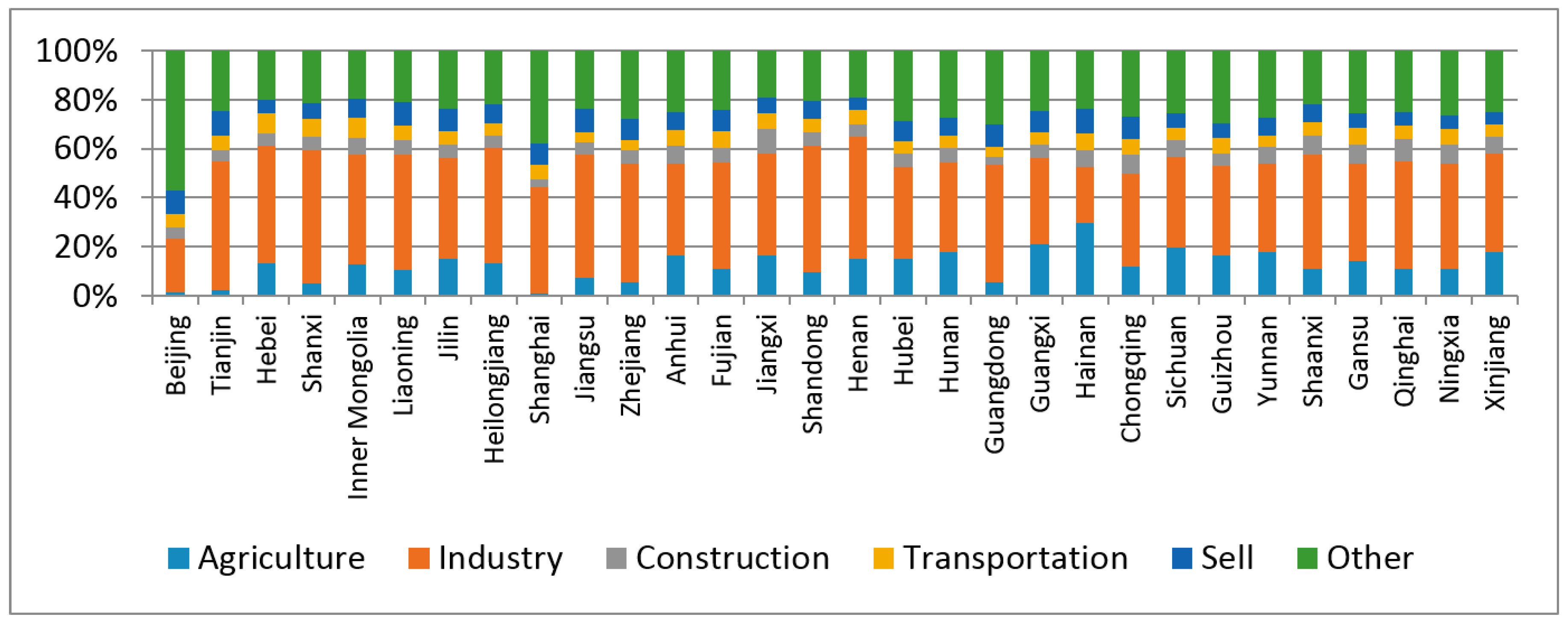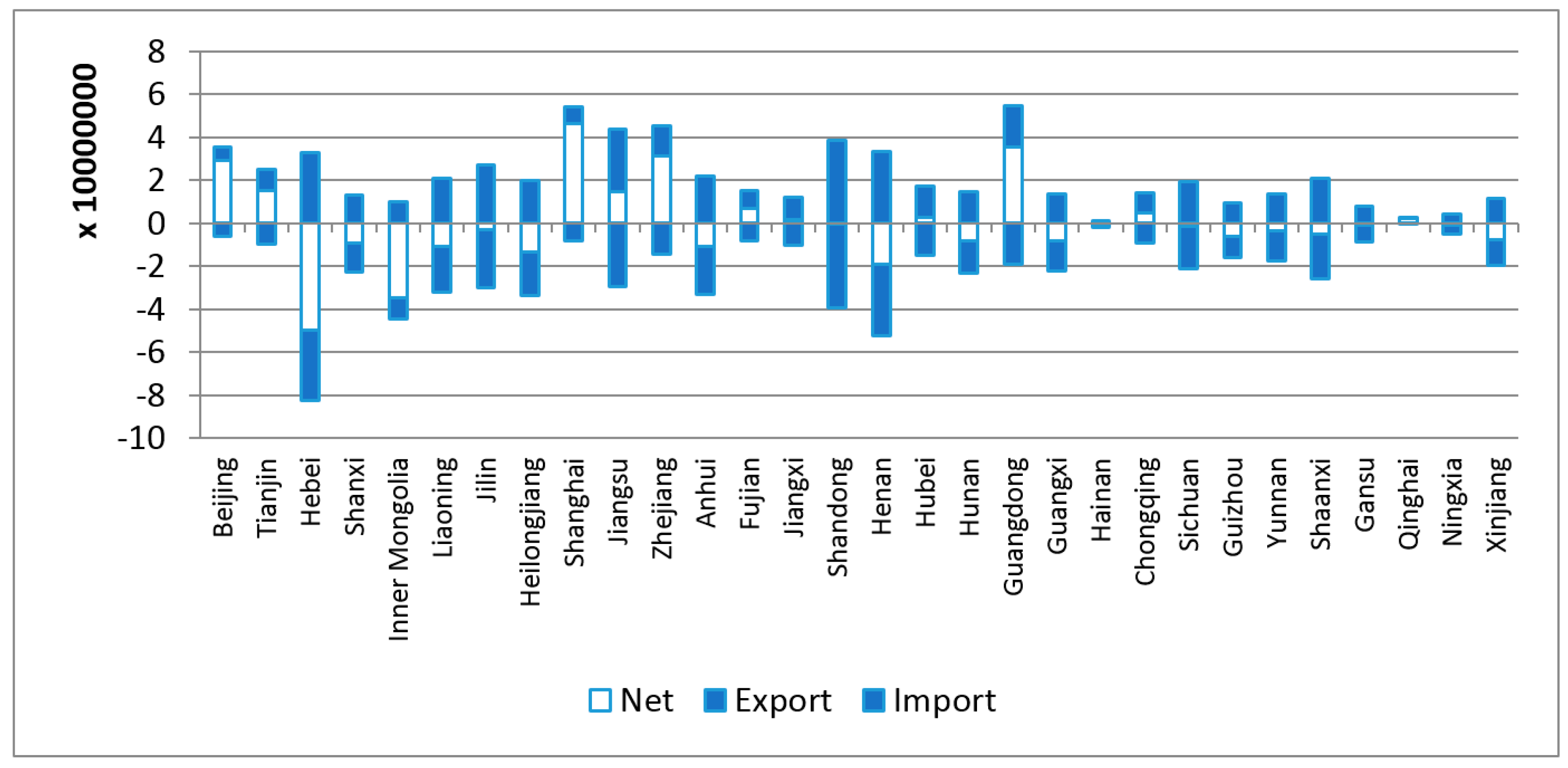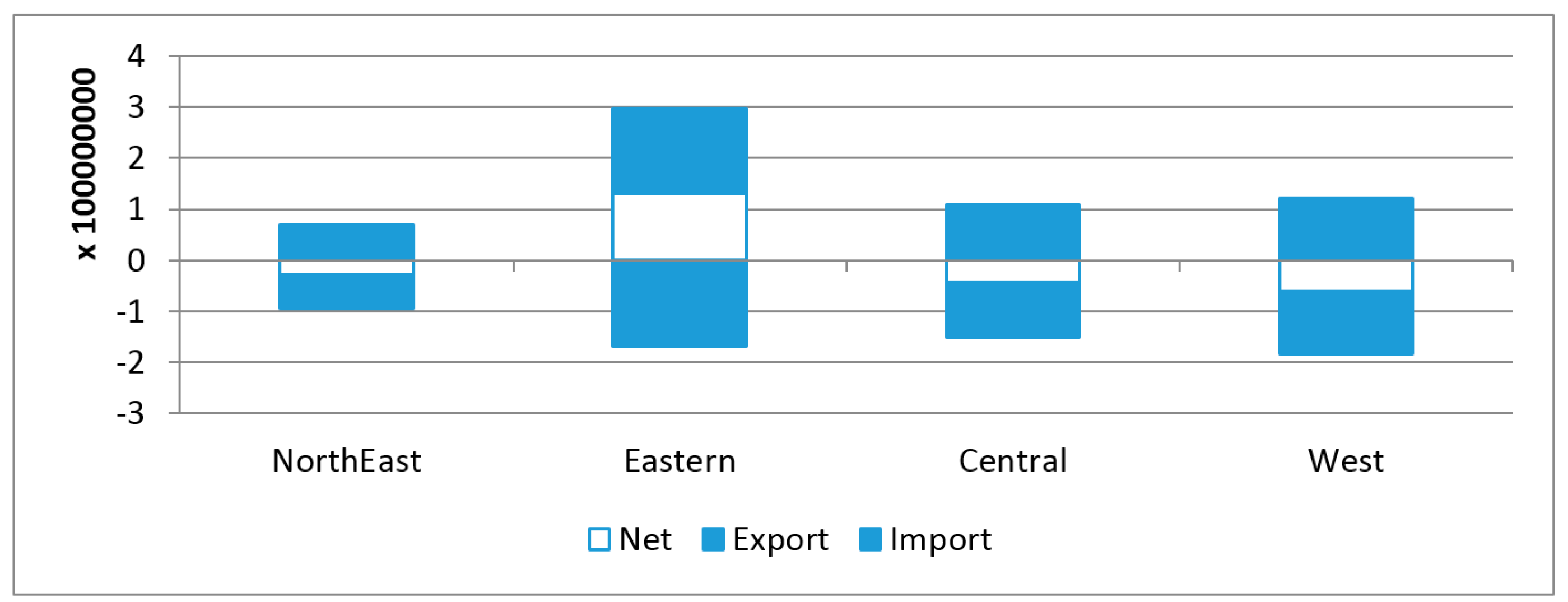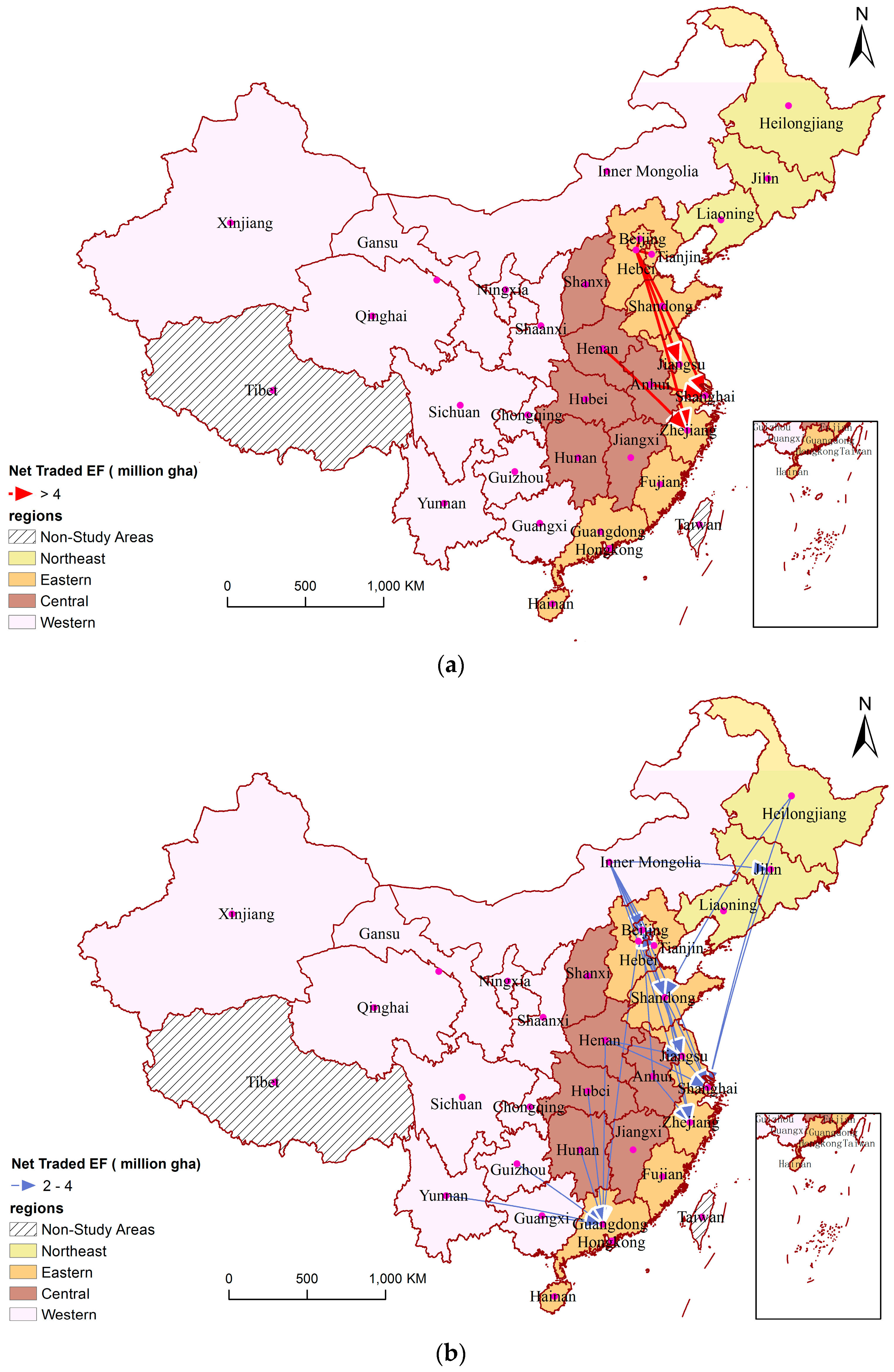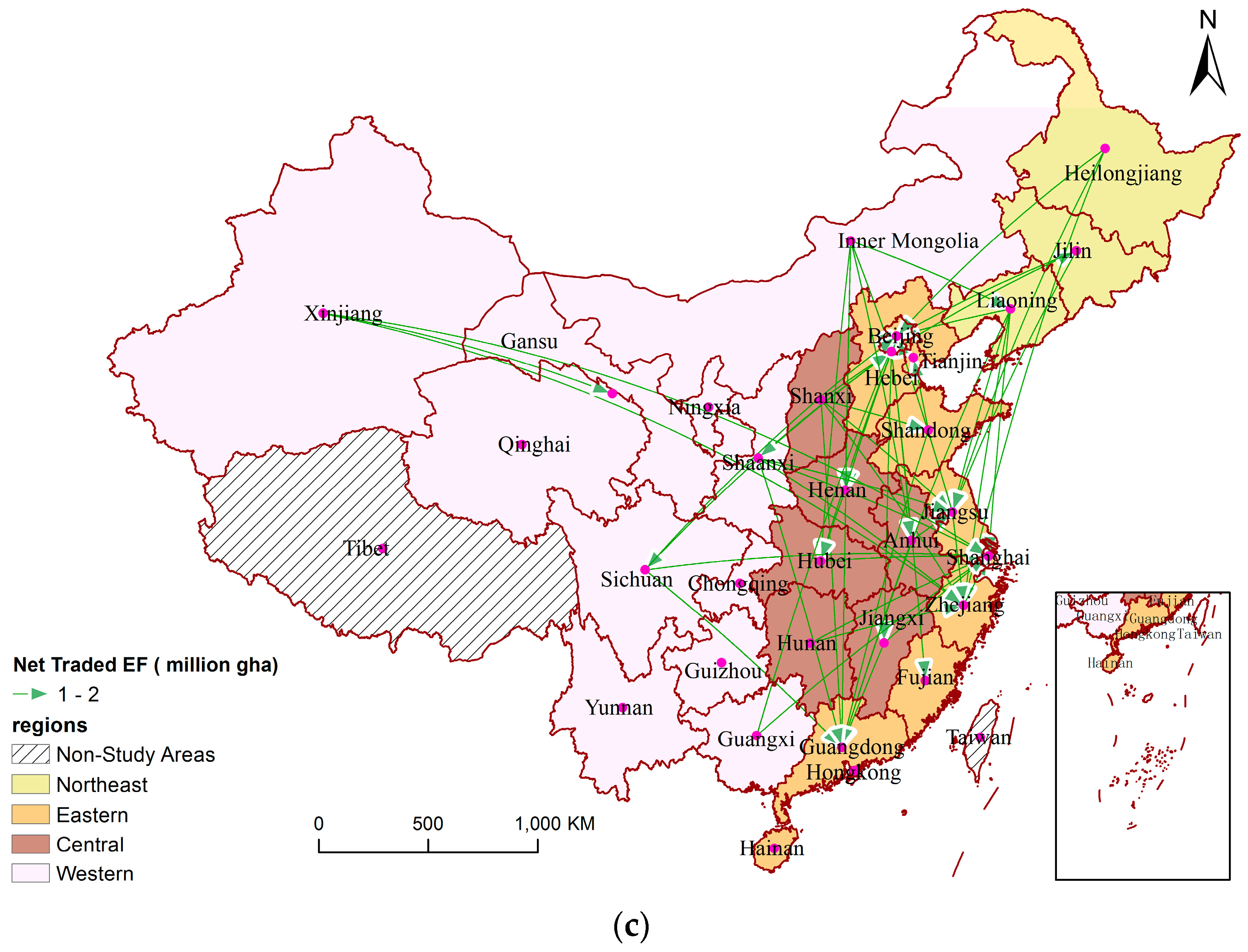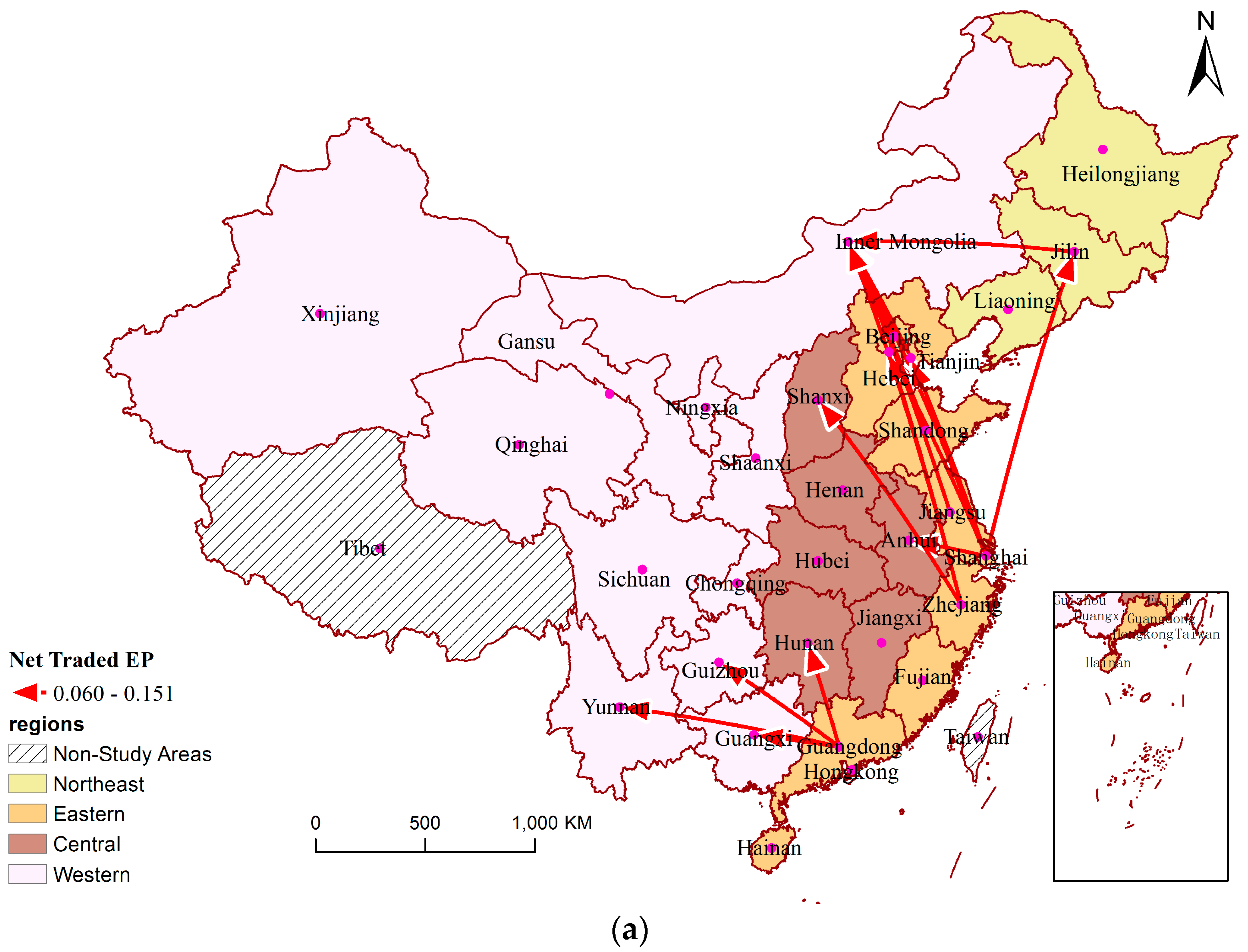4.1.1. Provincial EF and Biocapacity (BC)
In 2007, the total EF of China (30 provinces in this study) was 16.67 billion gha, which was 1.5 times the value of BC for the year. The per capita EF was 1.27 gha. Of the six footprints, the carbon footprint had the most serious ecological sustainability issues in terms of the total footprint and mainly provided all provincial forest EPCs greater than 1.
As shown in
Figure 4, significant differences are observed among the values for the 30 provincial EFs in China in 2007. The EFs of Shandong, Henan, Guangdong and Jiangsu are the four highest regions, reaching 162 million, 117 million, 101 million and 92 million gha, respectively, and accounting for 9.78%, 7.06%, 6.12% and 5.52% of all national EFs, respectively. These four provinces have large populations and specific driving factors: Shandong is an energy-based province; Henan is China’s grain production base; and Guangdong and Jiangsu have well-developed industries. It is worth noting that Qinghai is the smallest province in terms of EF with 8.86 million gha, which is only 5% of Shandong’s EF. This result is mainly related to the reduced development of Qinghai, Ningxia, Xinjiang and Gansu regions and their small economic scales, minimal industrial structures and low per capita consumption levels. Because of the small populations, the EFs of Hainan and Tianjin are also relatively small. In Beijing, the total EFs are among the highest of the municipalities of Shanghai; although the population is relatively small, the high per capita consumption level is high.
Moreover, the BCs of Shandong and Henan, at more than 100 million gha, are ranked as the top two in China and account for 10.42% and 9.62% of the national BC, and these BC values are larger than the EF proportions. However, the BCs of Guangzhou and Jiangsu only account for 4.77% and 4.82% of the national BC, and these values are less than the EF proportion. The non-equilibrium of regional ecological resources involves significant differences in ecological deficits.
According to the footprint types, most of the blue line shown in
Figure 5a is below the orange line, which indicates that the overall sustainability of arable land is relatively improved. Provinces with EF > BC are mainly divided into two categories. Beijing, Tianjin, Shanghai, Zhejiang, Fujian and Guangdong represent economically developed provinces in which the proportion of agricultural land is decreasing because of industrialization and the population is relatively large because of migration. According to natural endowments, the arable lands of other regions, such as Shanxi and Qinghai, are relatively small, and these regions also show ecological deficits.
Figure 5b shows that the forest BC are necessitated by the production of forest products and carbon up-take, which require a significant amount of forest resources. In 2007, the ecological resource of all 30 provinces showed deficits, and the largest ecological deficit (ED) was observed in Shandong Province at 61.71 million gha, followed by Jiangsu, Zhejiang, Henan and Guangdong, which had EDs of 48.02, 43.88, 40.65 and 39.86 million gha, respectively.
Figure 5c provides a provincial comparison of the grazing lands of the eight provinces that showed deficits in 2007 (Beijing, Shanxi, Shanghai, Zhejiang, Guangdong, Chongqing, Gansu and Qinghai). These deficits were much smaller than those of forests and arable lands because of the reduced demand for grassland products in China.
Figure 5d compares the fishery resources and shows that most of the provinces are in a state of EF > BC, which is sustainable. Moreover, surpluses are observed in certain coastal provinces, such as Liaoning, Jiangsu, Zhenjiang, Shandong and Guangdong. The dotted line in
Figure 5e is almost straight, indicating that the built-up ED of the 30 provinces is small.
4.1.2. Per Capita EF, Per Capita BC, EPC and EPP for Each Province
Each provincial per capita EF reflects the local consumption level of final use, and this value is useful for analyses based on personal consumption.
Figure 6 demonstrates the differences between the total amounts of EF and BC per capita for each province. Overall, the EFs of 30 provinces except Guangxi, Hebei, Heilongjiang and Xinjian are in a state of ecological deficit. Shanghai, Beijing and Tianjin, which represent three of China’s four municipalities with high population densities and personal consumption levels (3.03, 2.91 and 1.85 ten thousand yuan, respectively), present the most serious ecological deficits.
We employ the indicator EPC, which is calculated by Formula (4), as an intuitive method of expressing the sustainable state of the local environment. The EPC values of the 30 provinces are divided into four levels. As shown in
Table 5, the provinces in level I (EPC ≤ 1) are Heilongjiang, Hebei, Xinjiang and Guangxi, which reflects sustainable development that is close to the threshold; and the per capita BCs of these four provinces are 1.19, 1.14, 1.31 and 0.91 gha, respectively, which exceeds the national average of 0.84, whereas the per capita EFs are 1.17, 1.12, 1.29 and 0.91 gha, respectively, which are close to or below the national average EF per capita of 1.27. Therefore, the ecological sustainable development of the four provinces would benefit from good natural endowments, a reasonable population size, and a reasonable level of ecological consumption.
For 20 provinces, the EPCs are between 1 and 2 and the EDs are no higher than the regional corresponding BC; thus, these provinces are placed into level II. The sub-indexes of EPC are obviously different among the provinces. Arable EPCs that exceeded 1 are observed in Guangdong, Qinghai and Fujian at values of 1.61, 1.23 and 1.11, respectively. The per capita arable BC for Guangdong and Fujian is small, and the arable EFs per capita are 0.25 and 0.23, respectively, which is much lower than the national average of 0.36. Qinghai is a special example with an extremely small population and minimal consumption structure. Because of the need for more forests for the absorption of CO2, each province in level II exceeds the threshold value for forest EPC, and the most serious cases are in Qinghai, Inner Mongolia and Jilin at values of 83.64, 20.39 and 12.60, respectively. Grazing EPCs are relatively smooth, and only the EPCs of Guangdong, Qinghai, Gansu and Chongqing are excessive at values of 1.32, 1.24, 1.04, and 1.02, respectively. Because of the significant differences between the provinces with regard to fishing resources, the differentiation of per capita fishing BC is significant, which can be explained by the rich fishing resources and higher fishing BC per capita of the coastal provinces, including Hainan, Fujian, Shandong, Jiangsu, Liaoning and Guangdong, all of which have fishing EPCs of less than 1. Inland provinces such as Hubei, Anhui, Hunan, and Jiangxi, which have rich inland lakes, are still in a state of sustainable development. Provinces in the western and other arid regions with fewer fishing resources are as follows (in descending order): Qinghai, Gansu, Shaanxi, Jilin, Guizhou, Inner Mongolia, Chongqing, Henan, Yunnan, and Sichuan. For the built-up EPC, the provinces are in a state of sustainable development except for Shaanxi, which has a slightly excessive value of 1.01.
Ningxia, Shanxi and Zhejiang are in level III and have EPCs between 2 and 5, and their per capita EFs are 2.11, 1.58 and 1.55 gha, respectively, which exceed the national average value. The BC per capita of Shanxi and Zhejiang is far below the national average, and the Ningxia BC is only slightly higher than the national average.
These results show that Shanghai, Beijing and Tianjin are municipalities with large population densities, large ecological carrying capacities, and EF gaps. As shown in
Table 5, the EPC is 15.09, 8.45 and 6.31 and the sub-pressure indexes for arable, forest, grazing, fishing and built-up land are greater than 1 except for the built-up EPC of Tianjin, which represents severe ecological sustainability at level IV.
The EPC reflects the number of years that a local BC must support domestic consumption, which is a type of pressure in consumption; however, the local ecological pressure in production (EPP), which expresses the local realities of EP, must be determined, and it is calculated according to the EF of local production divided by the local BC. The gap between the two indicators of the region is mainly caused by the embodied EF flow.
As shown in
Figure 7, both the EPC and EPP of the 30 provinces are larger than 1 except the EPC of Heilongjiang, Hebei, Xinjiang and Xinjiang, which means that regardless of the EPC or EPP, ecological sustainability issues in China were serious in 2007. A reduction of the embodied EFs is necessary to reduce the stress from a consumption perspective; however, the pressure from production should not be ignored. Provinces such as Heilongjiang, Hebei, Xinjiang and Guangxi have had sufficient BC to support local consumption because of the exports of embodied EFs in the form of industry shifts, and the actual utilization of the ecological resources is beyond that of the local BCs. However, the EPCs of Shanghai, Beijing, Tianjin and Zhejiang are all much larger than their corresponding EPPs because embodied EFs are imported. To achieve an interregional ecological balance, the local industrial structure, consumption levels, and ecological balance estimates should be studied to determine the EF intensity by total EF and sector, and the embodied EF flows among the regions according to the total EF, EF type and sector will be studied in the following sections.
